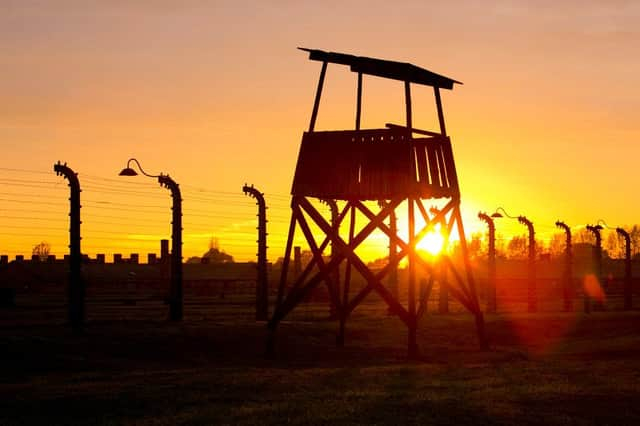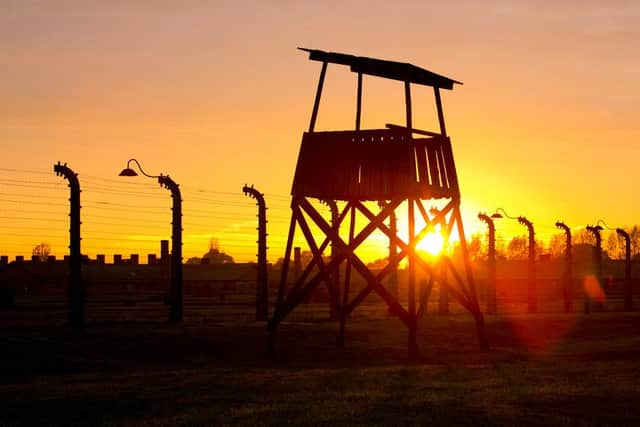Holocaust Memorial Day: Editor reflects on visit to Auschwitz


Holocaust Memorial Day is on January 27 as on January 27, 1945 the largest Nazi concentration camp, Auschwitz-Birkenau, which is in modern-day Poland, was liberated by the Soviets, nearly eight months before the war officially ended.
Our editor, Mike Rankin, along with pupils from Angus and across Scotland, visited Auschwitz in October.
This is what he wrote after his trip...


Advertisement
Hide AdAdvertisement
Hide Ad“If we each take a minute’s silence to remember every person who was murdered here, none of us would speak for the next two years.”
This stark fact brought a gasp from the 200-odd Scottish school pupils gathered for a memorial service at the ruins of Crematoria 11, Birkenau, two weeks ago.
The speaker was Rabbi Barry Marcus MBE and he gave an impassioned talk to the Fifth and Sixth Year students, adult educators and members of the press who had travelled to Eastern Poland courtesy of the Holocaust Educational Trust as part of their Lessons from Auschwitz Project.
Rabbi Marcus made the point: “Hearing is not like seeing - we need to see for ourselves, however painful, if only to strengthen our resolve not to forget the memory of the millions who were so mercilessly butchered.


Advertisement
Hide AdAdvertisement
Hide Ad“It’s my belief that we cannot face the challenges of the future without identifying with our past.”
Earlier, the party had flown into Krakow and embarked on coaches for the hour’s drive to Oswiecim - renamed Auschwitz by the Nazis - and bright sunshine, blue skies and countryside not unlike Angus, Tayside and Fife was totally at odds with our destination.
In total, the Nazis built six death camps, all on Polish territory, of which two - Majdanek and Auschwitz-Birkenau - also functioned as work camps.
Auschwitz was established as a concentration camp within months of the Nazi occupation of Poland. The existing brick built barracks, constructed between the wars, were functioning as a camp by the end of 1940, the first transport of political prisoners from the town of Tarnow having arrived in June and including a number of Jews.
Advertisement
Hide AdAdvertisement
Hide AdPrior to the arrival at the camp we stopped off at the Auschwitz Jewish Centre, site of the Great Synagogue and a Jewish cemetery. We learned that Poland’s Jewish community before the Second World, at 3.3 million, was the largest in Europe. Today, it stands at around 10,000.
We also heard that anti-semitism was still alive and well in the 21st century. Gravestones had been vandalised and swastikas painted on the cemetery walls several times over the past few years.
Arriving at the gates of Auschwitz 1 was also something of a surprise. Oswiecim has a population today of 40,000 and is located on a major railway junction where lines converge from Warsaw, Berlin, Prague and Vienna. The barracks are on the outskirts of the town.
The message above the main gate - Arbeit Macht Frei, which means ‘Work Will Set You Free’ - is one of the notoriously iconic images. It’s estimated around 1.2 million people entered the Auschwitz-Birkenau complex and never left. As well as being a state museum it is also a cemetery, very possibly the biggest in the world.
Advertisement
Hide AdAdvertisement
Hide AdA tour of the barracks is sobering. They include a Gestapo block where prisoners were subject to “kangaroo courts” before being sentenced to death.
Many were killed by firing squad, and in a small courtyard next to the block is a “shooting wall” where women, in particular, were forced to stand with their faces against the wall and shot in the back of the head. Many of them were naked.
In the cell blocks we were shown “standing cells”. where up to four people would be incarcerated at night and then marched to work the next day. Needless to say, the rate of attrition was pretty much 100 per cent.
At first, as well as being tattooed, prisoners were also photographed. As numbers grew, those destined to die were not registered at all. On the barracks walls are portraits with the name, occupation, date of their incarceration and subsequent death contained in a legend beneath.
Advertisement
Hide AdAdvertisement
Hide AdBundles of human hair shorn from women prior to being murdered, shoes of all kinds - from high fashion to work boots, ethnic cleansing being a great leveller - pots and pans, brushes and shaving tackle, suitcases bearing the names and addresses of the owners are all on show, silent testament to the horrific scale of the crime perpetrated on these people.
The gas chamber and crematorium at Auschwitz 1 is a chilling place - there are no words to describe it. Just several hundred yards away, and another world for the inmates at the time, can be seen behind trees and a garden wall the upper stories of the house in which camp commandant Rudolph Hoess and his family lived. Reportedly they were “very happy” there.
Also located at the rear of the gas chamber is the scaffold from which Hoess was hung in 1947 after being convicted of war crimes!
Birkenau, just up the road, is a large open space with a few of the wooden barrack huts still standing. We learned that the railhead gatehouse - perhaps the best known image from this hellish place - was a relatively late addition to the complex. Constructed in spring 1944, it brought the railway spur right into the heart of the camp and up to the ‘‘selection ramp’’ close to Crematoria 11 and 111. Previously, the victims were marched a kilometre or two from the transports which was deemed to be “less economical”.
Advertisement
Hide AdAdvertisement
Hide AdThe ramp was where prisoners were selected for work or to be murdered in the gas chambers located underground. Those being sent there were told they would be taking a shower prior to admittance to the camp.
Cold-blooded deceit extended to well-tended flower gardens which surrounded the buildings, pegs in the undressing room being numbered, the Sonderkommando - prisoners who worked inside the crematoria - told those undressing to remember their peg number so they could find their clothes afterwards, and even string was given out to tie shoes together.
The crematoria were destroyed by the Nazis at the end of the war in an attempt to cover their tracks. In my opinion, the rubble left behind to this day was a most appropriate backdrop for Rabbi Marcus’ very powerful service, in which he concluded: “People ask: where was God in all this?
“The answer is: WHERE WAS MAN?”
Scottish pupils had this to say about their visit...
The Auschwitz-Birkenau Museum and Memorial has an education department and runs courses for Polish teachers.
Advertisement
Hide AdAdvertisement
Hide AdThe key challenge facing the museum, now that Poland is a member of the EU, is dealing with the ever-increasing number of visitors. Over the past few years, visitor numbers have risen dramatically, by approximately 250,000 annually.
One of the issues is that many teachers grew up in the Communist era and their understanding of Auschwitz-Birkenau was coloured by the site being depicted as a place of Polish martyrdom. The education department has worked on educating teachers about the wider issues of the site and further developments are set to take place.
However, there are no straightforward answers as to how to treat a site of genocide.
Forfar Academy pupil Rachael Reid said she had difficulty in getting her head round what had happened there: “Having seen it, I can’t really take in the scale of it but visiting this place is going to change the way I see things from now on.
Advertisement
Hide AdAdvertisement
Hide Ad“I’m certainly going to be involved in raising funds for the Holocaust Trust through our school.”
Carnoustie High pupils Brooke Duncan and Fiona Muirhead both agreed that you had to see it to really understand the Holocaust.
Fiona added: “We all have our own problems, but when you think about the people who came here and what happened to them then you realise things could be so much worse.”
Brooke said: “It’s very interesting, and we will pass on our findings to others.”
Advertisement
Hide AdAdvertisement
Hide AdDundee pupils Kelsey Harvey and Abbie Walker, from Braeview Academy, have studied Hitler and Germany during the Second World War.
Abbie said: “We wanted to see where this happened. You just can’t believe how many people came here to their deaths, nor how oblivious the world was to it. So many people were gassed and cremated here.”
Panashe Dzambo, from Viewforth High in Kirkcaldy, said: “I thought it would bring things to light. Coming here is different from just hearing or reading about it.
“You can relate what happened to situations occurring around the world to this day and it’s important to learn from that.”